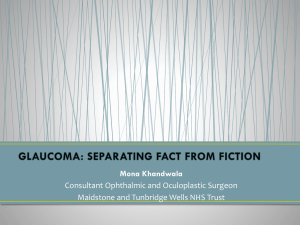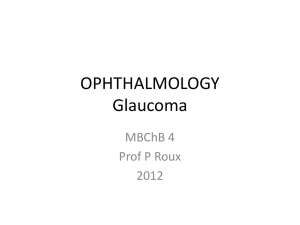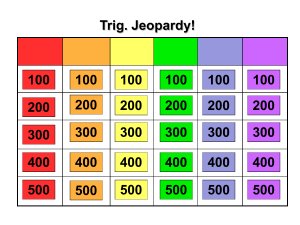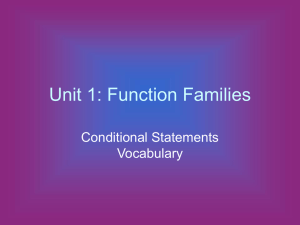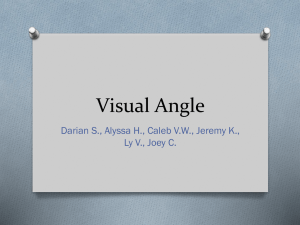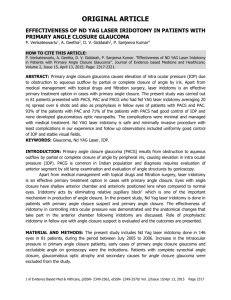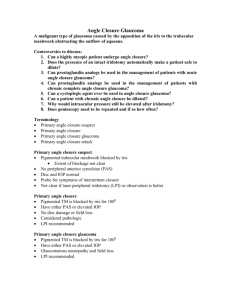Acute Eye Conditions Course
advertisement
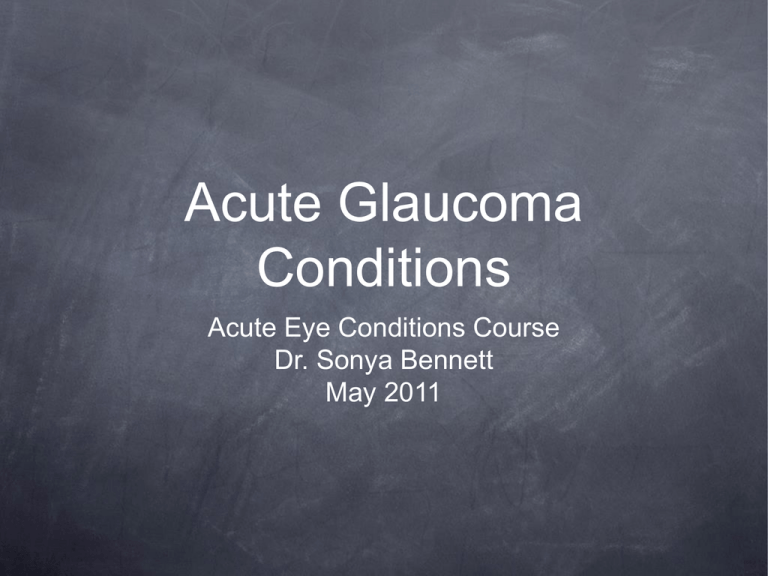
Acute Glaucoma Conditions Acute Eye Conditions Course Dr. Sonya Bennett May 2011 Glaucoma isn’t usually thought of as an emergency condition........ unless it’s that bad one aka “acute glaucoma” Classification Primary angle closure ± glaucoma Secondary angle closure ± glaucoma Acute angle closure crisis Primary open angle glaucoma Secondary open angle glaucoma Primary Angle Closure drainage angle occludable from primary mechanism (iris trabecular meshwork contact in three or more quadrants), with either raised IOP and/or primary peripheral anterior synechiae and if optic nerve damage = glaucoma picture of pupil block Secondary Angle Closure similar clinical findings in angle/AC though caused by “posterior pushing mechanism”: secondary pupil block from uveitis (seclusio pupillae and iris bombe) lens induced - phacomorphic, anterior subluxation, traumatic lens dislocation malignant glaucoma Secondary Angle Closure Retinopathy of prematurity / PHPV Choroidal expansion from: drugs, posterior scleritis, AIDS, PRP, arteriovenous fistulas anterior neovascularisation Acute Angle Closure Crisis complete occlusion of drainage angle resulting in sudden elevation of intraocular pressure (IOP) Clinical signs: hazy cornea, fixed mid-dilated pupil, IOP >21mmHg, shallow anterior chamber Symptoms: blurred vision, nausea & vomiting, headache Acute Angle Closure Crisis Examination: VA, IOP, slit-lamp examination, gonioscopy, undilated optic disc viewing, fellow eye assessment think about and look for the mechanism of closure during the examination Acute Angle Closure Crisis Medical management Eyedrops: beta blockers, alpha agonists, carbonic anhydrase inhibitors and pilocarpine oral or intravenous acetazolamide oral hyperosmotic agent (glycerol) if safe for patient Acute Angle Closure Crisis Medical Management Intravenous hyperosmotic agents (mannitol) it safe for patient topical glycerin/glycerol eyedrops to improve the view topical steroids Acute Angle Closure Crisis Surgical treatment peripheral iridoplasty early if IOP not lowering AC paracentesis for temporary IOP lowering - usually reserved for cases where other treatment has failed Laser peripheral iridotomy: YAG, argon/diode. Treat fellow eye also! Acute Angle Closure Crisis Surgical treatment Lens extraction - often effective in refractory cases and/or if significant cataract present trabeculectomy not usually performed (50% failure rate) Acute Angle Closure Crisis if you are sure of a secondary non pupil block mechanism (especially if it is atypical and asymmetric) then use atropine Case NM 91 yr old frail woman (double amputee)referred from rest-home with three week history of red aching eyes and reduced vision bilaterally seen at local private practice: VA HM, 3/60; IOP 68, 53 mmHg, hazy corneae and shallow ACs diagnosed with acute angle closure crisis: topical timolol, brimonidine, pred forte and oral diamox 250mg administered Case NM arrived at GCC A&E: IOP 54, 48. Bilateral YAG Laser peripheral iridotomy performed IOPs one hour later were 18, 14 discharged home on combigan BD and pred forte Q2hrly OU Case NM returned for review 2 days later: IOP 46,23 corneae a little clearer, difficult view of disc as very dense cataracts drainage angle closed synechially in 3/4 quadrants OD Case NM phaco/PCIOL OD 2 days later, subTenon’s anaesthesia generalised zonule weakness noted intraoperatively so capsular tension ring inserted corneal oedema gradually settled and UAVA 6/9 optic nerve OD 0.9 Case NM IOPs 17, 14 on Latanoprost nocte, Combigan BD OU planning phaco/PCIOL OD in the next month or two - VA 6/18, angle very narrow but open in 2 quadrants, hazy view of disc 0.3 Open Angle Glaucoma Emergencies If IOP > 40mmHg Primary: not common, but possible (younger) Secondary: trauma-related, steroid response, hyphaema, pigment dispersion syndrome, pseudoexfoliation, Posner-Schlossman syndrome, phacolytic glaucoma, ghost cell glaucoma Thank you


